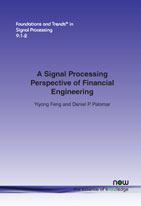A Signal Processing Perspective on Financial Engineering
By Yiyong Feng, The Hong Kong University of Science and Technology, Hong Kong, yiyong@connect.ust.hk | Daniel P. Palomar, The Hong Kong University of Science and Technology, Hong Kong, palomar@ust.hk
Abstract
Financial engineering and electrical engineering are seemingly different areas that share strong underlying connections. Both areas rely on statistical analysis and modeling of systems; either modeling the financial markets or modeling wireless communication channels. Having a model of reality allows us to make predictions and to optimize the strategies. It is as important to optimize our investment strategies in a financial market as it is to optimize the signal transmitted by an antenna in a wireless link. This monograph provides a survey of financial engineering from a signal processing perspective, that is, it reviews financial modeling, the design of quantitative investment strategies, and order execution with comparison to seemingly different problems in signal processing and communication systems, such as signal modeling, filter/beamforming design, network scheduling, and power allocation.
A Signal Processing Perspective on Financial Engineering
Despite the different nature of financial engineering and electrical engineering, both areas are intimately connected on a mathematical level. The foundations of financial engineering lie on the statistical analysis of numerical time series and the modeling of the behavior of the financial markets in order to perform predictions and systematically optimize investment strategies. Similarly, the foundations of electrical engineering, for instance, wireless communication systems, lie on statistical signal processing and the modeling of communication channels in order to perform predictions and systematically optimize transmission strategies. Both foundations are the same in disguise.
It is often the case in science that the same or very similar methodologies are developed and applied independently in different areas. A Signal Processing Perspective on Financial Engineering is about investment in financial assets treated as a signal processing and optimization problem. It explores such connections and capitalizes on the existing mathematical tools developed in wireless communications and signal processing to solve real-life problems arising in the financial markets in an unprecedented way.
A Signal Processing Perspective on Financial Engineering provides straightforward and systematic access to financial engineering for researchers in signal processing and communications so that they can understand problems in financial engineering more easily and may even apply signal processing techniques to handle some financial problems.
